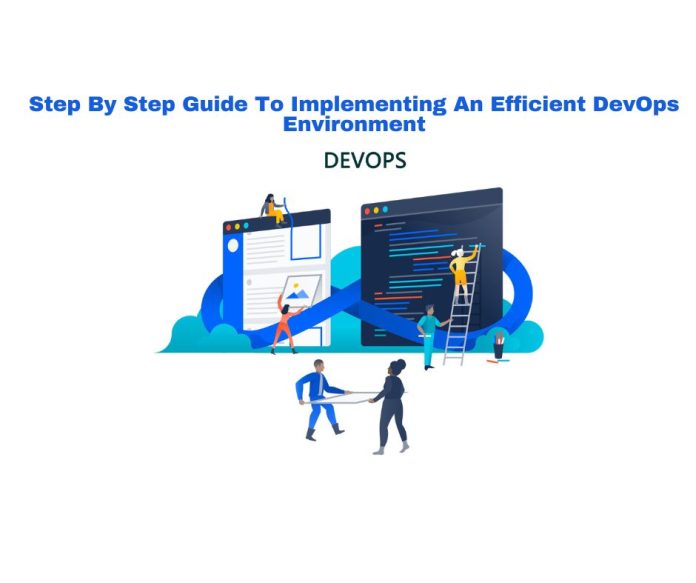In order to implement an efficient DevOps environment, you first need to take a look at your existing infrastructure. This analysis will help you to understand the different roles and responsibilities that are necessary in order to operate an effective DevOps pipeline. After you’ve identified these roles and responsibilities, it’s important to create the right organizational structure so that everyone is aware of their assigned duties and goals.
Next, it’s time to get your automation tools set up. By using automation tools, you can streamline your development process and ensure that everything is running as smoothly as possible. You can also use automation tools for testing and monitoring purposes, which will help you keep track of all the changes that are made during development. Finally, it’s important to establish strong communication between different teams so that everyone is on the same page and understands what needs to be done in order to successfully deploy your software into production. Adopting an agile methodology will help expedite the development process while minimizing risks associated with potential mistakes.
Once everything is in place, it’s time for testing and monitoring! By performing automated testing throughout the entire development process, you can catch any potential problems early on before they become major problems. And by continuously monitoring your system architecture and performance, you can ensure that everything runs smoothly once it goes live into production. In short – implementing an efficient DevOps environment requires a comprehensive analysis of your current infrastructure as well as a well-planned organizational structure with the appropriate automation tools in place!
Tooling The Agile Transformation
As the world of business continues to rapidly change, so too does the way that we develop and deploy our software. Gone are the days when software development and deployment was a slow and labor-intensive process. Today, automation is key to ensuring that this process is as efficient as possible.
Automation has many benefits for both developers and administrators alike. Developers can be freed up to work on more important tasks, while administrators can focus on more strategic tasks. In addition, automation allows for a faster turnaround times for new releases, which can be critical in a rapidly changing marketplace.
However, there are also some challenges associated with automation. For example, it’s important to make sure that we’re not sacrificing quality in exchange for speed. We also need to ensure that our monitoring and reporting systems are able to keep up with the rapid pace of change. And finally, we need to make sure that our systems are able to handle unforeseen spikes in traffic or load without crashing or going offline.
Overall, an Agile transformation is an essential tool in modern business. By using automation as a key part of this transformation, we can achieve dramatic efficiency gains across all aspects of our development process.
Automate And Standardize DevOps Processes
DevOps is an important and widespread software development process that aims to improve the efficiency of software development. It does this by automating common tasks and processes, standardizing them across teams, and managing different environments with configuration management tools. This article will outline the benefits of adopting DevOps culture, how automation simplifies DevOps, and how you can use configuration management tools to manage your DevOps processes in real time.
Adopting DevOps culture is one of the biggest advantages of using Dev ops technology. By implementing best practices such as automated testing and continuous deployment, you can reduce the amount of time needed to develop and deploy new software. Additionally, by standardizing your processes across teams you can increase collaboration and communication between members of a development team. This will help to ensure that all members are on the same page when it comes to developing code.
Configuration management tools are also essential for managing your DevOps process efficiently. These tools allow you to automate repeatable tasks and keep track of changes made to your codebase in real time. This allows you to make quick decisions about whether or not changes should be made live immediately or tested first before going live with your customers. In addition, monitoring, reviewing, and improving your DevOps processes in real time is crucial for ensuring that everything runs smoothly on a day-to-day basis. By constantly improving your process you’ll be able to avoid common errors that can cause delays in software development cycles.
Prioritizing Agile Automation In DevOps Workflows
Devops is a process that combines the concepts of software development and systems administration. By integrating automation into their workflow, DevOps professionals are able to increase their efficiency and scalability. Automation can be used in a number of ways to support the goals of DevOps, including improving system reliability and performance, reducing stress on developers, and freeing up resources for more important work.
In this section, we will outline some of the benefits of automation in DevOps processes and discuss some specific platforms that are being used to automate DevOps operations/workflows. We will also cover security considerations when automating your DevOps environment, as well as strategies for combating legacy infrastructure issues. Finally, we will provide tips for integrating automation into existing DevOps processes and discuss ways to monitor workflow performance with automated tools. By understanding the role of automation in DevOps workflows, you can improve your efficiency and scalability while combating legacy problems with improved security measures.
Conclusion
This article in the dailytimezone must have given you a clear idea about DevOps is the process of combining Development and Operations teams to create a unified and collaborative approach to software engineering. The adoption of DevOps can bring significant benefits, including improved team collaboration, faster time to market, and increased cost savings. However, it is important for organizations to be aware of the challenges that come with implementing a DevOps environment, such as cultural resistance and tooling complexity. With an effective strategy in place, organizations can develop a robust DevOps ecosystem that supports their agile transformation goals while overcoming common obstacles. By following this step-by-step guide, organizations will be able to successfully implement an efficient DevOps environment that meets their needs.




